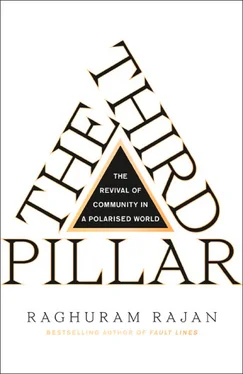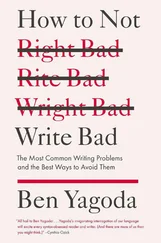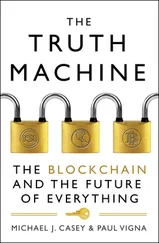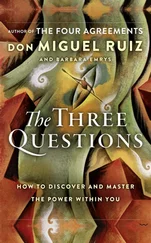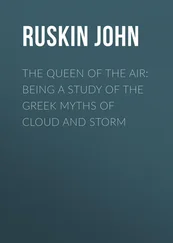1 ...8 9 10 12 13 14 ...30 Too Little Incentive to Change
We have just seen that self-interested people do not take into account the loss of benefits to community health when they transact outside the community. Equally problematic is when they rely overly on community support when they make individual decisions, staying too long within the community when the outside makes more sense. One situation where such incentives may be at work is when an important source of livelihood in the community is threatened by technological change or trade. A well-documented tragedy of the Industrial Revolution in England is the fate of the handloom weavers. 22
The automation of spinning toward the end of the eighteenth century meant that there was much more yarn available to be woven. Automated power looms were only slowly being introduced, so there was strong demand for the labour of handloom weavers to weave the now abundantly available yarn into cloth. Unfortunately, the writing was on the wall – these jobs would be automated also. Indeed, because it was costly to let expensive power looms lie idle, the handloom weavers were already the first to be deprived of work when business slowed. Nevertheless, even as wages in handloom weaving fell as automation and the entry of workers created a labour surplus, the numbers joining the handloom weaving sector continued to increase. Eventually many ended up unemployed and destitute. Why did so many workers continue to stay in, or join, an industry that was so clearly doomed?
We will see such behavior again in modern United States. The explanation cannot be disassociated from community. Handloom weaving meant following the traditional family occupation, staying at home in the village with family and community close by, and enjoying all the benefits of community support. Changing jobs would mean moving to a dirty slum in a town and working in a hot, noisy factory. For the individual household that moved, this would have also meant foregoing the support the community could offer, and essentially tearing up all the implicit claims they had on it. Staying, even if the likelihood of job loss was high, was made less unpleasant by the prospect of community support.
As the entire handloom weaving industry collapsed, though, the weaver communities were severely weakened and unable to provide the support that was expected of them. Destitute unemployed weavers were forced to petition for public support from the government, which never came – in fact, the Poor Act in England was reformed in 1832 to tighten the conditions of eligibility for public relief. 23While it would not be fair to place the entire burden of this tragedy on the community, it is reasonable to conclude that the presence of the community can distort the decisions of its individual members. When trade and technological change affect many members of the community, their suboptimal individual decisions can end up dragging the community down with them as they place too much of a burden on it.
THE COSTS OF INSULAR COMMUNITIES
Communities through history have understood how detrimental the free and unconstrained choices of their members can be to community survival. For much of history, this did not matter because people had few alternatives, and change was slow. At times of great change, however, communities have had to react. Some of their actions may have made the communities much less useful in promoting social well-being.
Take, for example, the problem of excess outside choice that we discussed earlier. Most obviously, communities can prohibit or restrict contacts between their members and the outside, especially if such contacts can infuse new and uncomfortable ideas or make members more economically independent of the community. As we will see in the next chapter, feudalism was an example of enforced community, and was perpetuated by severe restrictions on what people could do.
Such restrictions are not imposed solely to protect the community, they also protect the powerful in the community against challenge and the community from desirable change. Ellen Barry of the New York Times followed the travails of a group of women from the Nats community in Meerut, a few miles from New Delhi. 24During the wedding season, the community men worked as musicians in wedding bands, but begging was the traditional off-season occupation for the community. As India started exporting buffalo meat in large quantities, some women started to work in a nearby meat-processing factory, and earned considerably more than their husbands. With the women contributing to family finances, and reducing the extortionate stranglehold of moneylenders, the male elders of the caste, some of whom not coincidentally were moneylenders, struck back. They decreed that the women should stop work, ostensibly so that they would not be exposed to the sexual advances of outside men.
The real reason, Barry surmised, was that the women’s earnings had begun to undermine the existing order. When some of the women refused to obey the decree, they were ostracised by the community. Of course, when community members want to break free, ostracism may have little punitive effect, so it was followed by violence. The women were forced to appeal to the police and the judiciary to protect them, as well as to ensure their constitutional right to work. In older India, neither would the job opportunity have arisen nor would the legal system be open to helping them. Markets and the state do open up the community, reducing the extent to which it can become oppressive.
In addition to remaining small to build relationships, the community may also need to remain small if it is to share information effectively. 25Apart from the costs of foregone growth, information sharing has its downsides. The community can be very intrusive and cloying, poking its nose in members’ private affairs. Gossip can be helpful in straightening out aberrant behavior, but it can also be mean, hurtful, and intolerant of deviance from age-old traditions. Transparency can highlight budding problems, but those in the community fishbowl, naked to the view of all, may be civil in public while hiding seething resentment. By comparison, the anonymity of the city can be liberating, even though it distances us from social relationships.
The pressure in some communities to stay small and only transact internally can also come at some cost to the broader system. Medieval Chinese master craftsmen typically found apprentices within the family or the close-knit clan. In contrast, the guild system in Europe allowed masters to take on apprentices from almost anywhere, and apprentices, on becoming masters, similarly could move to their hometowns to set up their workshops. According to economic historians de la Croix, Doepke, and Mokyr, a consequence of the looser guild structure in Europe was that technical knowledge was shared widely, improved upon, and shared again. 26In contrast, it remained relatively stagnant when confined within the clan in China. They argue that this can explain the vast improvements in Europe between 1500 and 1750 in a variety of technical areas, such as watchmaking, relative to China. It is a lesson that we will take to modern times when we examine firms and patent rights later in the book.
Communities may also try and hold together by overemphasising traditions as the source of the community’s strengths. In doing so, the community risks making members suspicious of the choices presented by the modern world, allowing them to become trapped by the past. This is particularly problematic in matters of science. Economic historian Joel Mokyr argues that a major spur to the scientific discoveries in the seventeenth century was the realisation that Aristotle’s scientific observations were often wrong. 27Equally energizing for scientific progress was the comfort that contemporary scientists like Galileo, Newton, and Leibnitz had extended the boundaries of knowledge far beyond what was contained in the ancient texts, and there was nothing extraordinary or eternal about the classics. This led scholars to challenge old knowledge in every area, breaking from their earlier conformism. In contrast, centres of Islamic learning, perhaps to promote the commonality and thus cohesiveness of historic Islamic thought in a rapidly expanding and disparate community, turned their gaze backward. Islamic scholars, whose predecessors had kept scientific knowledge alive and expanding during Europe’s Dark Ages, started studying older Islamic texts to uncover their eternal verities, and contributed little to the progress of science from the thirteenth century onward.
Читать дальше
